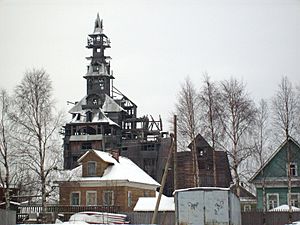Building code facts for kids
A building code is a set of rules for how buildings should be designed, built, and kept safe. These rules help protect everyone's health and safety. Governments create and enforce building codes. They often send inspectors to check if buildings follow these rules.
Building codes cover many different things. They are influenced by people who make building materials, firefighters, and building experts. For example, a building might need rules about parking spaces or how it affects traffic. There are also important rules to make sure buildings are safe during disasters like fires, earthquakes, or tornadoes.
The rules for a building can change a lot depending on where it is and what it's used for. For instance, a house will have special rules to make it a safe place to live. A hotel will have extra rules about fire exits. Many public buildings also have a "maximum occupancy." This means there's a limit to how many people can be in a room at one time.
Earthquake Safety Rules
Building codes often include rules to make buildings safer during earthquakes. These rules help structures deal with the shaking and movement an earthquake can cause.
There are two main types of earthquake rules:
- Prescriptive codes: These give minimum requirements for how strong a building needs to be.
- Performance-based codes: These focus on how a building should behave during an earthquake. For example, they might say a building should not collapse or be badly damaged.
Even with these rules, following them exactly does not always guarantee a building will be perfectly safe from all damage in a very strong earthquake. But they greatly reduce the risk of collapse.
Images for kids
See also
 In Spanish: Código de edificación para niños
In Spanish: Código de edificación para niños



